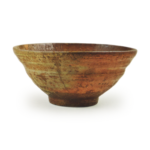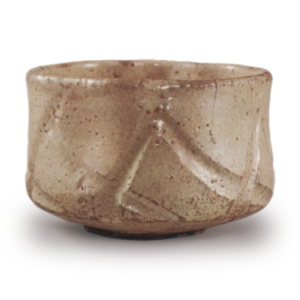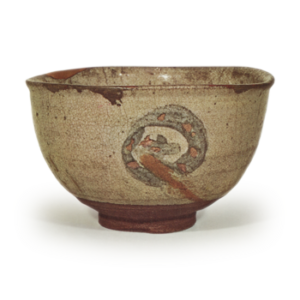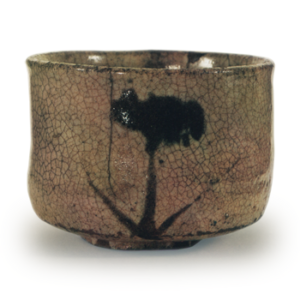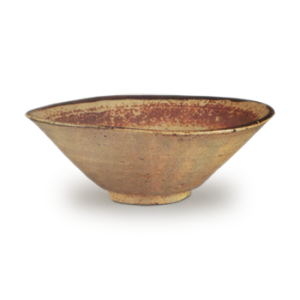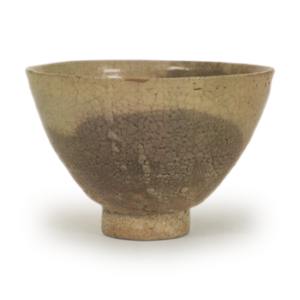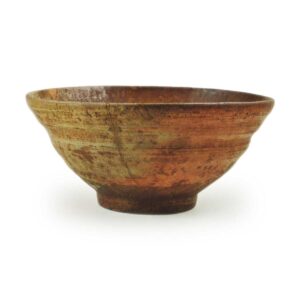
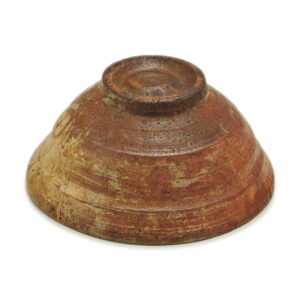
Height: 6.8 – 7.2cm
Diameter: 14.5 – 15.2cm
Outside diameter of foot ring: 6.1cm
Height of foot ring: 1.0cm
There are various types of pottery, and they can be broadly divided into two categories: honte and hirame. Even within the category of honte, there are many variations, including pottery with a light brown clay body that contains little iron, pottery with a purple clay body that contains a lot of iron, , and there are also those that are thin and elegant in their workmanship, and those that are slightly thick and dignified, etc., and the workmanship varies, but the only thing they have in common is that they all have a thin glaze. It is also thought that there is a considerable range in the age of their firing.
This tea bowl is probably an old work among the Hontei and Tōya that I have seen, and as such, it has a dignified feel to it throughout, and in particular, the strength of the foot ring is outstanding even among Hontei and Tōya. The thick, well-sculpted foot is knobby, and although the inside of the foot is not very deep, it is largely sculpted in a whorl shape, with the center of the helmet being the largest, and the remaining part being a creased texture.
The foot is marked with a series of lathe marks from the foot to the rim, giving the whole piece a dignified appearance. The upper part of the body is narrower and more slender, and the rim of the mouth is slightly cupped. The interior of the body is also covered in fine, strong-looking lathe marks, and in particular, there are two clear lines around the body, which also give the impression of strength. The center of the inside of the bowl is deepened by the whorls of the potter’s wheel marks, and there are about nine or ten smaller marks around it.
As is usual for Toto-ya ware, the inside and outside glaze is extremely thin, but the glaze is particularly rich in variety. The glaze on the outside is a mixture of blue and red, and there are both large and small spots on it, but the red areas are also like the color of a sunset or plum vinegar, and the blue areas are tinged with grayish green or are more blue, so there are various changes to be seen in the overall subdued color. The inside and outside are similar in that they are mostly reddish, but there are also patches of bluish-green tinged with gray and patches of reddish-brown of various sizes.
The name Tatsuta is probably derived from the Tatsuta River, a famous place for viewing autumn leaves, and refers to the variously changing colors of red, blue, greenish gray, and light brown. The purple-red ground reveals a fine, sticky texture, and there are about nine or ten marks on the raised tatami mat. There are three large cracks, and there are five places where the surface has been roughly repaired around the mouth.
It is housed in a black lacquered box, and on the front of the lid are the two characters “Ryūta” in silver powder script, and it is said that the calligrapher was Shōjō Shōkadō. Also, on the front of the black lacquered inner box is the word “Ryūta-chawan” written in red lacquer. In addition, there is a label on the body of the outer box, which reads “Yagura-denrai Uo-oya chawan Shokado mei Tatsuta”, and there is also a receipt attached, which reads “The right is the receipt for the payment for the Tatsuta chawan in the possession of the Yagura family. April 20th, 1886, Toda Yashichi of Osaka (signature)”.
The origin of the tea bowl is unknown, but it was passed down for a long time in the Yagura family, who were tea ceremony enthusiasts in Kyoto, and in 1886 it was passed on to Suzuki of Nagoya’s Ootaka through the mediation of Tanimatsuya Toda Yashichi of Osaka, and then passed on to the same name owner Yagi Heibei of the Matsunouken tea house in Fukuromachi, Nagoya, and after the Pacific War it came into the possession of the current owner.

